Snakes are very interesting reptiles that are famous for their variety of sizes and wide-ranging locations around the world. Unfortunately, they frighten many people because some of them are venomous. That means they can inject a poisonous substance into others, and it severely harms or kills them. The United States has many species of venomous snakes. Today we’re going to identify the largest venomous snake ever found in the United States.
We’ll tell you which species holds the title for the biggest venomous snake, show you where it lives, and inform you why you don’t need to worry about it that much.
What Is the Largest Venomous Snake Found in the United States?
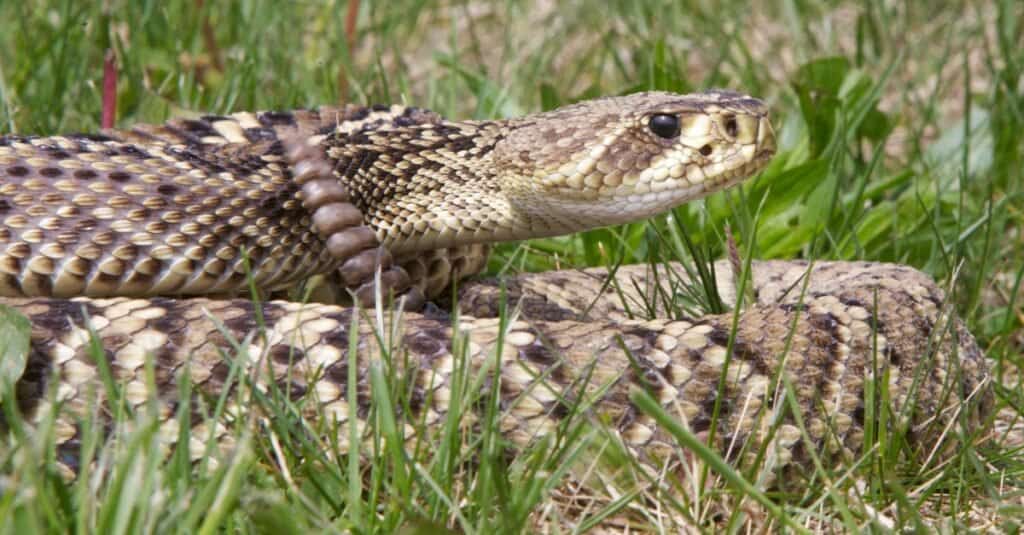
The Eastern diamondback rattlesnake is the largest venomous snake found in the United States
©iStock.com/NajaShots
The eastern diamondback rattlesnake is the largest venomous snake ever found in the United States, and the largest one ever discovered measured 94 inches in length and weighed 34 lbs. The massive snake was attributed to a person named Rutledge, but that is all the information available about that particular snake.
However, that length falls in line with the believed maximum possible length for the species. Still, very few reptiles have managed to reach anywhere close to that length.
One captive rattlesnake in the Central Florida Zoo and Botanical Gardens measures 88 inches in length. This well-known snake demonstrates the possibility for such massive reptiles to exist in the wild. After all, rattlesnakes don’t usually want to spend time around human beings.
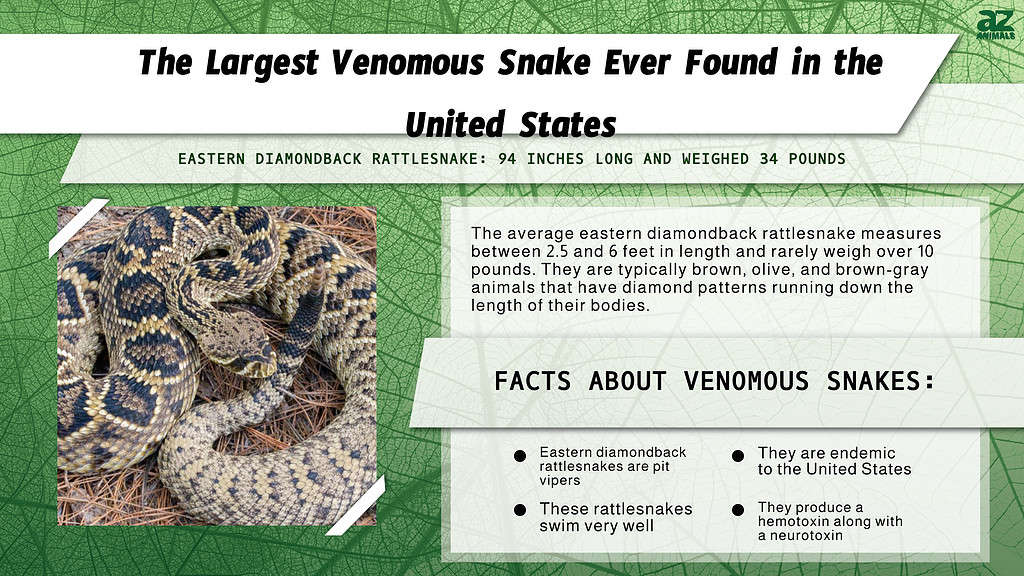
How Large is the Average Eastern Diamondback Rattlesnake?
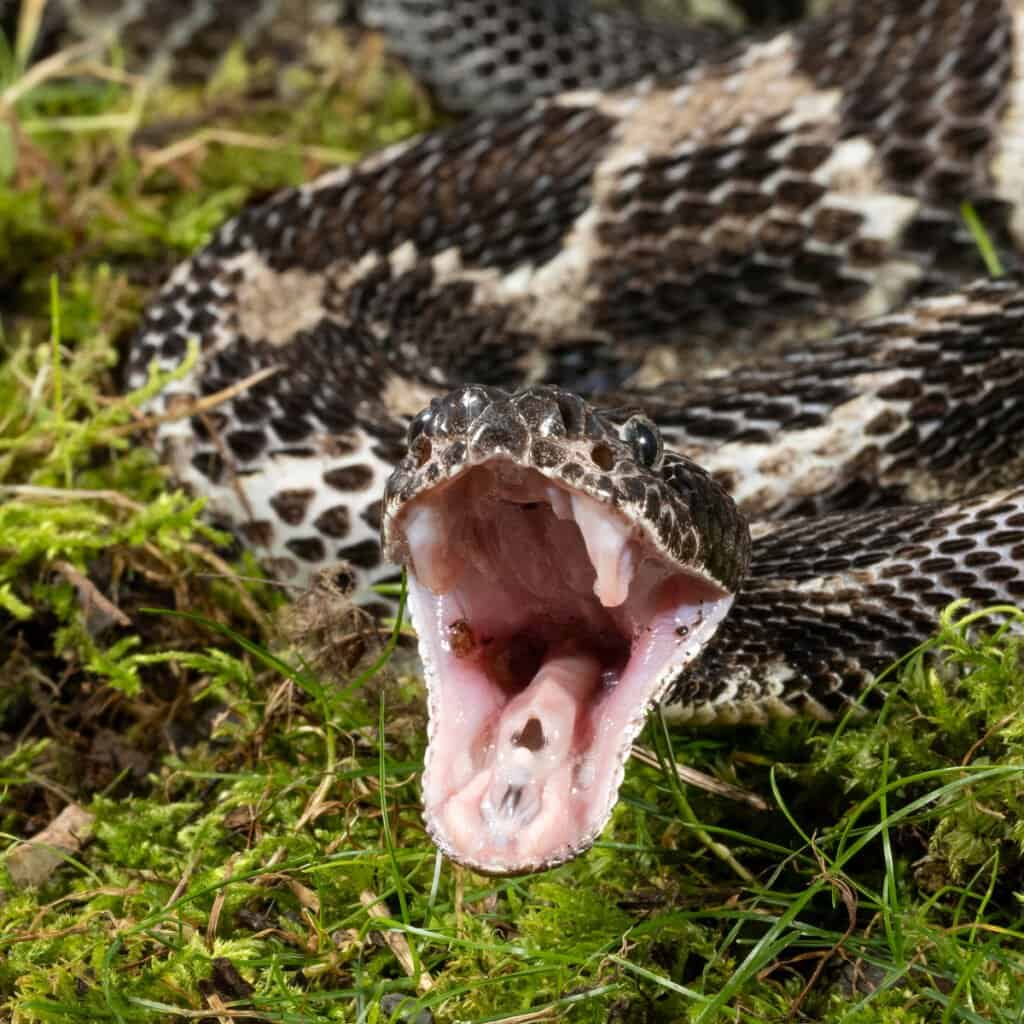
The average rattlesnake measures less than 6 feet and barely weighs 10 lbs
©Joe McDonald/Shutterstock.com
The average eastern diamondback rattlesnake measures between 2.5 and 6 feet in length and rarely weighs over 10 pounds. They are typically brown, olive, and brown-gray animals that have diamond patterns running down the length of their bodies.
At the end of this snake is a rattle that they use as a threat display. It makes a persistent rattling noise that sends a shiver up the spine of anyone who has encountered one before.
Knowing how small the typical eastern rattlesnake is should make the longest one ever recorded seem even more amazing!
Where Do Eastern Diamondback Rattlesnakes Live?
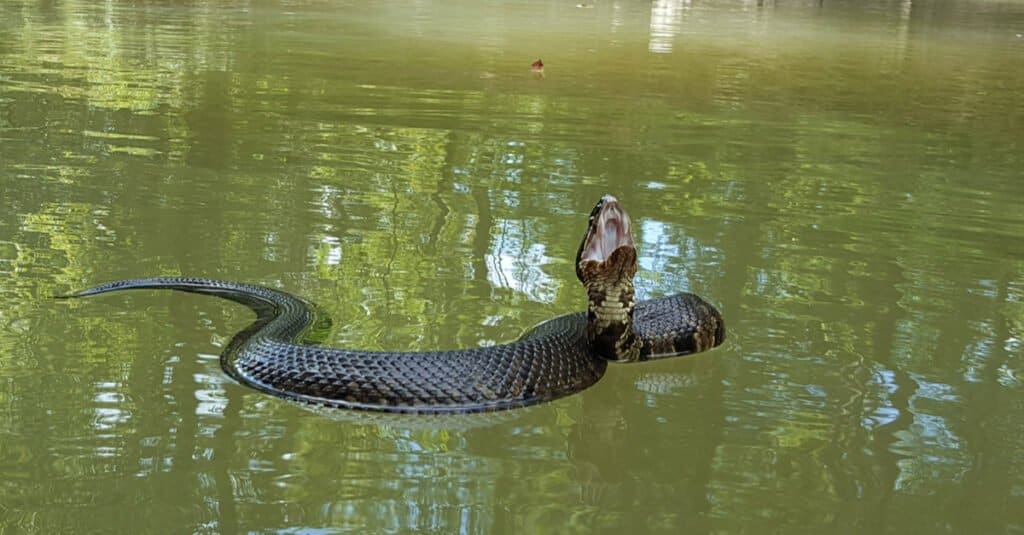
Eastern diamondback rattlesnakes can swim well, just like this
cottonmouth
©Seth LaGrange/Shutterstock.com
Eastern diamondback rattlesnakes are pit vipers that are endemic to the United States. Specifically, they live in the southeastern portion of the country in the states of North Carolina, South Carolina, Georgia, Florida, Alabama, Mississippi, and Louisiana. However, no one has seen the snake in North Carolina or Louisiana for a number of years.
Despite having a large range, the eastern diamondback is not a common sight. Human populations have expanded into their former territories. The fear of these snakes has led many people to kill them rather than remove them from their properties. To be fair, a rattlesnake bite can be deadly, especially to kids or pets.
Within those states, the eastern diamondback rattlesnake prefers to live in forests, marshes, woodlands, and wetlands. Interestingly, these rattlesnakes can swim very well. Many news stories have cropped up in the past about people boating in the ocean waters near the Florida Keys and spotting these snakes swimming.
Rattlesnakes can swim between islands and have been spotted miles away from shore. They reportedly have a very fluid swimming motion, but attacks in the water are very rare.
Rattlesnakes also swim in lakes and some rivers, too. Often, they’re just trying to get somewhere safe for food or shelter, so they aren’t going to swim out into the middle of a body of water just to attack you.
How Deadly is Eastern Diamondback Rattlesnake Venom?
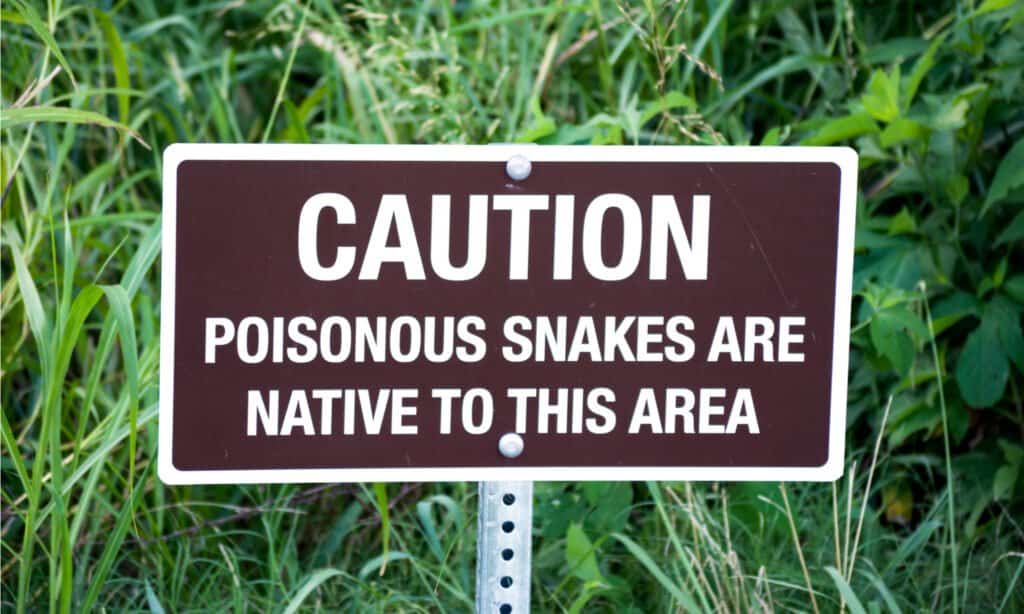
Rattlesnake venom can animals and humans of any age
©Jeff W. Jarrett/Shutterstock.com
Eastern diamondback rattlesnake venom can kill a fully grown adult human if they do not seek help once envenomated. Children and the elderly face a greater chance of dying as a result of these snakebites.
When we talk about how deadly rattlesnake venom is, we have to focus on two factors: the effects of the venom and antivenom.
Eastern diamondback rattlesnakes produce a hemotoxin along with a neurotoxin. This type of venom increases bleeding from the wound the fangs leave behind. The venom also causes body tissue to break down as well as necrosis, resulting in tissue, cell, and organ death. Meanwhile, the neurotoxin can cause paralysis in parts of the body.
Fortunately, many hospitals near rattlesnake habitats keep a highly successful antivenom in stock. Thus, if a person is bitten by a rattlesnake and seeks immediate help, they stand a good chance of surviving.
In the grand scheme of things, the eastern diamondback is not even in the top 10 deadliest venomous snakes in the world today.
If you are bitten by this snake or any other venomous snake, you need to stay calm and seek immediate medical aid to start administering the antivenom.
What Other Venomous Snakes Live in the United States?
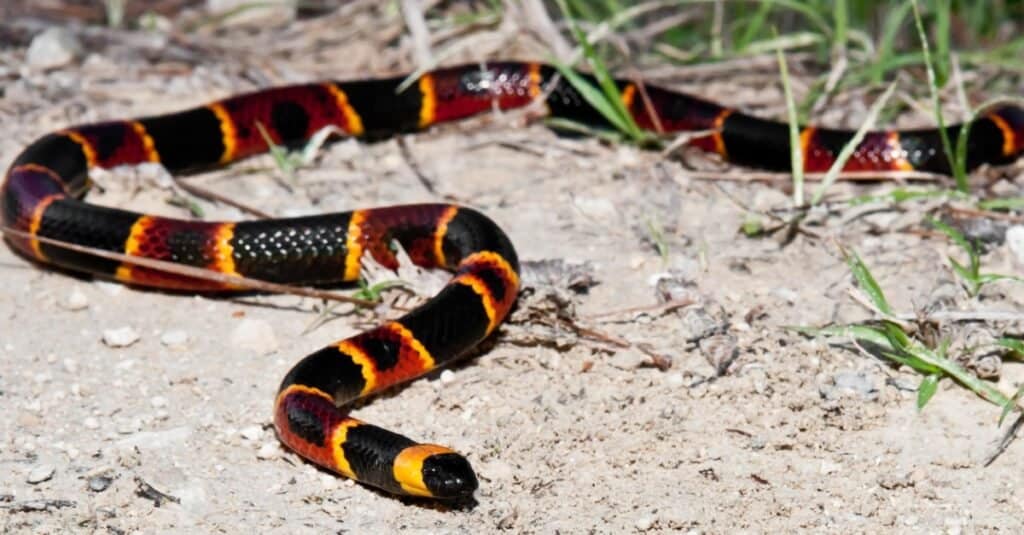
The coral snake might look interesting, but you need to stay away from them
©iStock.com/JasonOndreicka
The United States is home to roughly 30 species of venomous snakes within its borders. Most of these are different variants of rattlesnakes. However, you can also encounter cottonmouth, copperhead, and coral snakes.
Cottonmouths, aka water moccasins, are venomous, semi-aquatic pit vipers. They’re the only venomous water snake in North America, typically measuring 2-6 feet. Water moccasins have light and dark bands, white mouths, and spade-shaped heads.
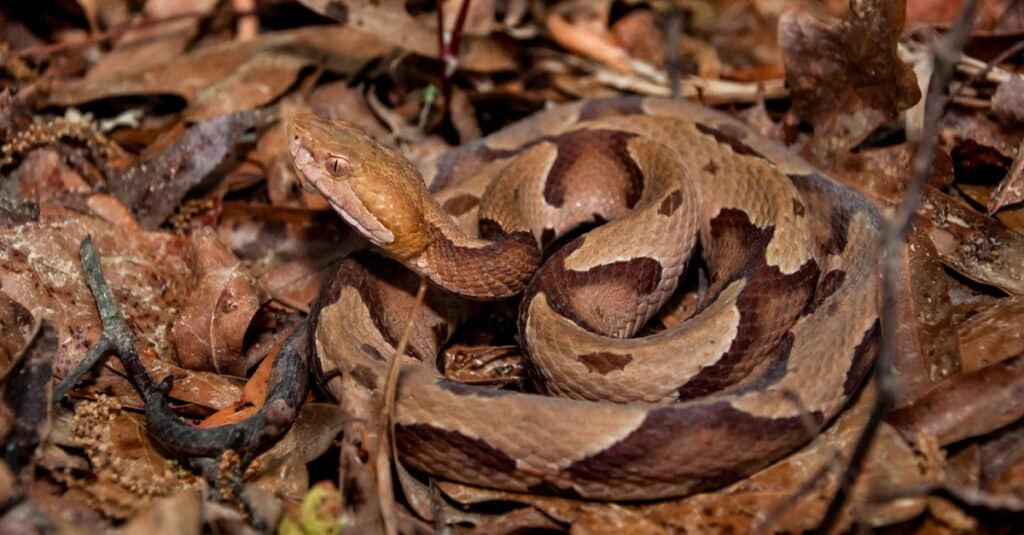
The Copperhead is another venomous snake that is found in America.
©Jay Ondreicka/Shutterstock.com
Out of all snake species in the U.S. copperheads are responsible for the most snake bites in America, despite not being very aggressive. Luckily, their venom isn’t too potent.
Coral snakes have some of the most potent venoms in the United States, but they are also among the rarest snakes that you’ll encounter. Furthermore, they are known for having short fangs that may not penetrate human skin through boots and thick pants, like jeans.
How Often Do Eastern Diamondback Rattlesnakes Kill People in the U.S.?
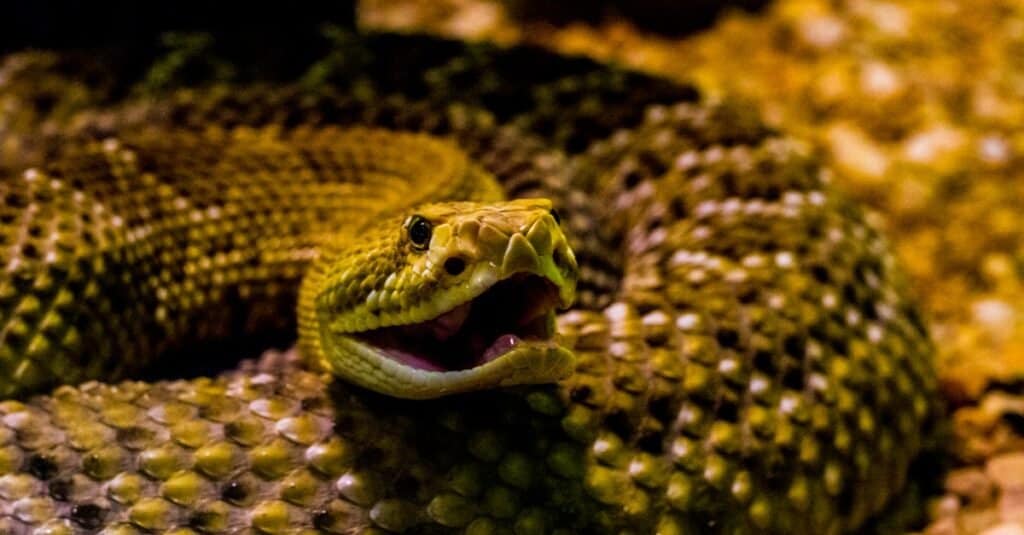
You can avoid snakebites by being aware of your surroundings and knowing what to do during an encounter
©iStock.com/Paulo Almeida
The Centers for Disease Control and Prevention estimates that anywhere from 7,000-8,000 people are bitten by venomous snakes every year. Fortunately, fewer than 10 die on average. A large reason that people survive is due to antivenoms. Still, long-term injuries from these snakebites do occur.
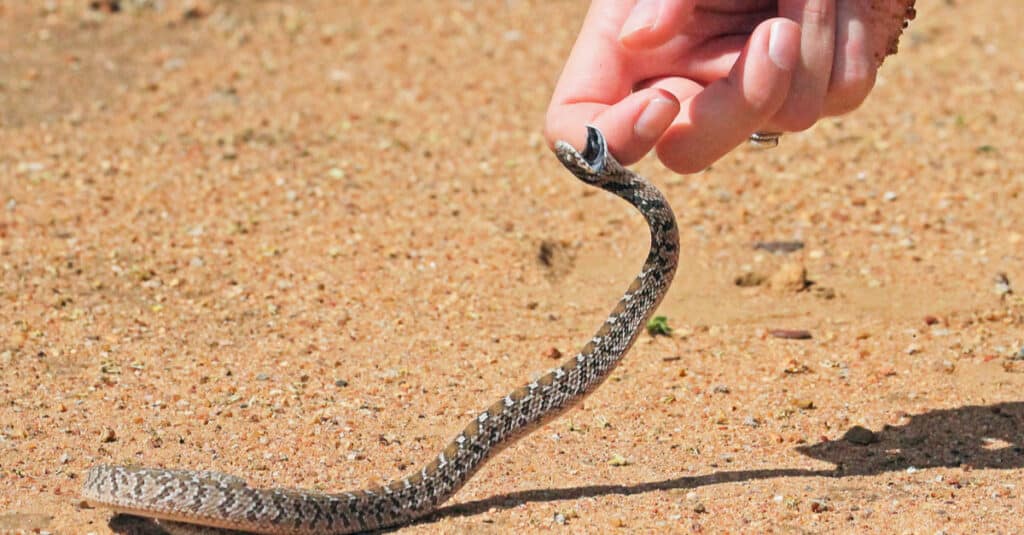
©Eugene Troskie/Shutterstock.com
That’s why it’s important to remember three rules when faced with any venomous snake:
1. Stop and Stay Calm
Do not scare the snake by screaming, flailing your limbs, or doing anything else that might make the snake think it’s in danger. They will usually attack only when provoked.
2. Do Not Get Any Closer
Some people spot snakes and then want to get a closer look to confirm their suspicions that it’s a venomous snake. Don’t try it.
3. Slowly Move Away
When you have assessed the situation, start to move away from the snake slowly. You do not want to be within striking distance of the snake if it starts to feel threatened. Don’t worry, the snake will not chase you.
If you follow these guidelines, you should be able to end your encounter with the scary reptile and go about your day. Just be mindful of where you saw the snake.
Eastern diamondback rattlesnakes are the largest venomous snake ever found in the United States. The chances of you encountering one are somewhat low, but they can appear in unusual places, like in the open ocean. Still, as we’ve shown, the chances of a snake biting you are low and the chances that you’ll perish are far lower.
Other Record-Breaking Snakes
While the largest venomous snake ever found in the U.S. is the eastern diamondback rattlesnake, there have been some other quite hefty venomous snakes tipping the scales, such as cottonmouth snakes. These snakes, unlike eastern Diamondbacks, are semi-aquatic, spending a lot of their time in the water or near it in fresh or saltwater habitats like rivers, streams, and lakes.
The typical cottonmouth snake averages around 3 feet in length and around 5 pounds in weight. However, the largest cottonmouth snakes ever recorded in the U.S. measure between 60-74 inches long (from 5 to over 6 feet long). The absolute largest cottonmouth ever captured was on the border of Virginia and North Carolina in an area dubbed Dismal Swamp. At a length of 74 inches, it is officially the longest cottonmouth ever recorded. Learn more about this famous cottonmouth in the article below.
The photo featured at the top of this post is ©
Discover the "Monster" Snake 5X Bigger than an Anaconda
Every day A-Z Animals sends out some of the most incredible facts in the world from our free newsletter. Want to discover the 10 most beautiful snakes in the world, a "snake island" where you're never more than 3 feet from danger, or a "monster" snake 5X larger than an anaconda? Then sign up right now and you'll start receiving our daily newsletter absolutely free.
Thank you for reading! Have some feedback for us? Contact the AZ Animals editorial team.






